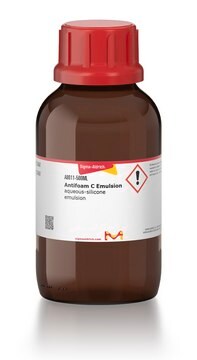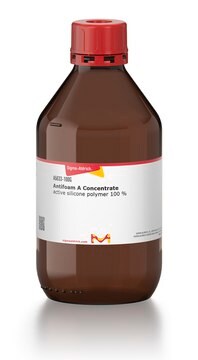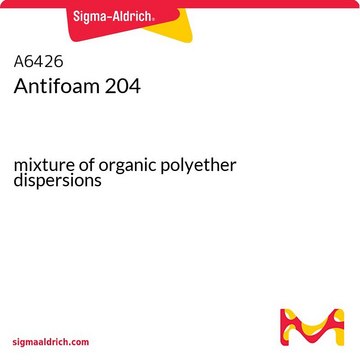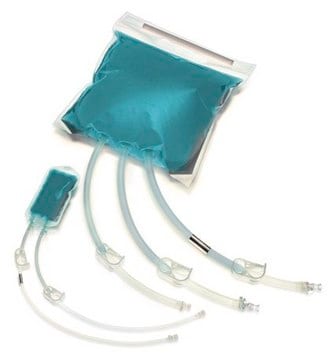A6582
Antifoam A concentrate
active silicone polymer 100%
Synonym(e):
Antifoam agent, Antifoam solution, Foam control agent
About This Item
Empfohlene Produkte
Qualitätsniveau
Form
emulsion (aqueous)
Methode(n)
cell culture | hybridoma: suitable
microbiological culture: suitable
Dichte
0.97 g/mL at 25 °C
Anwendung(en)
microbiology
Lagertemp.
room temp
Eignung
(Mammalian (suspension))
bacteria (fermentation)
Allgemeine Beschreibung
Anwendung
- in bioreactor culture for Staphylococcal enterotoxin C (SEC) production.
- to prevent foam formation during the aerobic treatment of sludge.
- to study the impact of surface tension on bioaerosol generation during bubbling.
Leistungsmerkmale und Vorteile
- Molecular biology grade and tested for use in bacterial fermentation.
- Extremely effective foam suppressor for aqueous and non-aqueous systems.
- Made of 100% active silicone polymer, free of emulsifiers.
- Typically, effective at 1-100 ppm.
- Product will be stable in the pH range of 5 to 9.
- Can be directly added to a fermentation medium but it is not recommended that it be pumped to a fermenter on an as-needed basis.
Komponenten
Angaben zur Herstellung
Ähnliches Produkt
Signalwort
Warning
H-Sätze
P-Sätze
Gefahreneinstufungen
Aquatic Acute 1 - Aquatic Chronic 1
Lagerklassenschlüssel
10 - Combustible liquids
WGK
WGK 3
Flammpunkt (°F)
>213.8 °F - closed cup
Flammpunkt (°C)
> 101 °C - closed cup
Persönliche Schutzausrüstung
Eyeshields, Gloves, type ABEK (EN14387) respirator filter
Hier finden Sie alle aktuellen Versionen:
Besitzen Sie dieses Produkt bereits?
In der Dokumentenbibliothek finden Sie die Dokumentation zu den Produkten, die Sie kürzlich erworben haben.
Unser Team von Wissenschaftlern verfügt über Erfahrung in allen Forschungsbereichen einschließlich Life Science, Materialwissenschaften, chemischer Synthese, Chromatographie, Analytik und vielen mehr..
Setzen Sie sich mit dem technischen Dienst in Verbindung.









